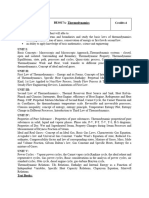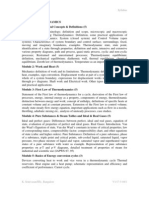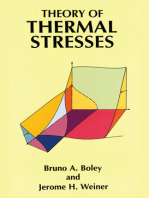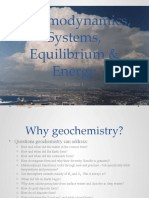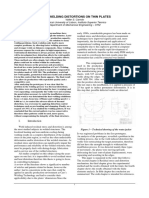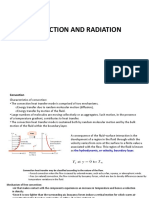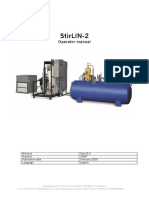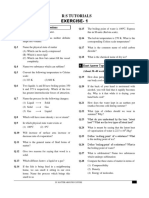THERMO
THERMO
Uploaded by
amireddysugunaCopyright:
Available Formats
THERMO
THERMO
Uploaded by
amireddysugunaOriginal Description:
Copyright
Available Formats
Share this document
Did you find this document useful?
Is this content inappropriate?
Copyright:
Available Formats
THERMO
THERMO
Uploaded by
amireddysugunaCopyright:
Available Formats
ME304ES: THERMODYNAMICS UNIT – III
Pure Substances, p-V-T- surfaces, T-S and h-s diagrams, Mollier Charts, Phase
B.Tech. II Year I Sem. L T/P/D CTransformations
4 1/0/0 4 – Triple point at critical state properties during change of
phase, Dryness Fraction – Clausius – Clapeyron Equation Property tables.
Pre-requisite: Engineering Chemistry and Physics Mollier charts – Various Thermodynamic processes and energy Transfer –
Steam Calorimetry.
Course Objective: To understand the treatment of classical Thermodynamics Perfect Gas Laws – Equation of State, specific and Universal Gas constants –
and to apply the First and Second laws of Thermodynamics to engineering various Non-flow processes, properties, end states, Heat and Work Transfer,
applications changes in Internal Energy – Throttling and Free Expansion Processes – Flow
Course Outcomes: At the end of the course, the student should be able to processes
Understand and differentiate between different thermodynamic systems and UNIT - IV
processes. Understand and apply the laws of Thermodynamics to different Deviations from perfect Gas Model – Vader Waals Equation of State –
types of systems undergoing various processes and to perform thermodynamic Compressibility charts – variable specific Heats – Gas Tables
Mixtures of perfect Gases – Mole Fraction, Mass friction Gravimetric and
analysis. Understand and analyze the Thermodynamic cycles and evaluate
volumetric Analysis – Dalton’s Law of partial pressure, Avogadro’s Laws of
performance parameters.
additive volumes – Mole fraction , Volume fraction and partial pressure,
Equivalent Gas const. And Molecular Internal Energy, Enthalpy, sp. Heats and
Tables/Codes: Steam Tables and Mollier Chart, Refrigeration Tables
UNIT – I Entropy of Mixture of perfect Gases and Vapour, Atmospheric air -
Introduction: Basic Concepts: System, Control Volume, Surrounding, Psychrometric Properties – Dry bulb Temperature, Wet Bulb Temperature,
Boundaries, Universe, Types of Systems, Macroscopic and Microscopic Dew point Temperature, Thermodynamic Wet Bulb Temperature, Specific
viewpoints, Concept of Continuum, Thermodynamic Equilibrium, State, Humidity, Relative Humidity, saturated Air, Vapour pressure, Degree of
Property, Process, Exact & Inexact Differentials, Cycle – Reversibility – Quasi saturation – Adiabatic Saturation , Carrier’s Equation – Psychrometric chart.
– static Process, Irreversible Process, Causes of Irreversibility – Energy in State UNIT - V
Power Cycles : Otto, Diesel, Dual Combustion cycles, Sterling Cycle, Atkinson Cycle,
and in Transition, Types, Displacement & Other forms of Work, Heat, Point
Ericsson Cycle, Lenoir Cycle – Description and representation on P–V and T-S diagram,
and Path functions, Zeroth Law of Thermodynamics – Concept of Temperature
Thermal Efficiency, Mean Effective Pressures on Air standard basis – comparison of
– Principles of Thermometry – Reference Points – Const. Volume gas
Cycles.
Thermometer – Scales of Temperature, Ideal Gas Scale
Refrigeration Cycles:
UNIT - II
Brayton and Rankine cycles – Performance Evaluation – combined cycles,
PMM I - Joule’s Experiments – First law of Thermodynamics – Corollaries –
Bell-Coleman cycle, Vapour compression cycle-performance Evaluation.
First law applied to a Process – applied to a flow system – Steady Flow Energy
Equation.
TEXT BOOKS:
Limitations of the First Law – Thermal Reservoir, Heat Engine, Heat pump ,
1. Engineering Thermodynamics / PK Nag / Mc Graw Hill
Parameters of performance, Second Law of Thermodynamics, Kelvin-Planck
2. Thermodynamics for Engineers / Kenneth A. Kroos ; Merle C. Potter/
and Clausius Statements and their Equivalence / Corollaries, PMM of Second
Cengage
kind, Carnot’s principle, Carnot cycle and its specialties, Thermodynamic scale
of Temperature, Clausius Inequality, Entropy, Principle of Entropy Increase –
REFERENCE BOOKS:
Energy Equation, Availability and Irreversibility – Thermodynamic Potentials,
1. Engineering Thermodynamics / Chattopadhyay/ Oxford
Gibbs and Helmholtz Functions, Maxwell Relations – Elementary Treatment of
2. Engineering Thermodynamics / Rogers / Pearson
the Third Law of Thermodynamics
You might also like
- ME 205 ThermodynamicsDocument3 pagesME 205 ThermodynamicsSherwinNo ratings yet
- ME 205 ThermodynamicsDocument3 pagesME 205 Thermodynamicsnandan144No ratings yet
- Thermodynamics SyllabusDocument2 pagesThermodynamics Syllabuserrohitverma25No ratings yet
- ETD-PREPARATION GUIDE - StrategyDocument2 pagesETD-PREPARATION GUIDE - Strategytamilselvan nNo ratings yet
- Mechanical MeasurementsMechanical MeasurementsDocument2 pagesMechanical MeasurementsMechanical MeasurementsNenu Na RakshasiNo ratings yet
- Engineering ThermodynamicsDocument3 pagesEngineering ThermodynamicsPanneer Selvam100% (1)
- Me6301 Engineering Thermodynamics L T P CDocument2 pagesMe6301 Engineering Thermodynamics L T P CHariharan HariNo ratings yet
- BE Syllabus of Mumbai Uni2Document9 pagesBE Syllabus of Mumbai Uni2Rajendra B PawarNo ratings yet
- Me 1007 Thermodynamics: Unit - 1 Basic Concepts and First Law of ThermodynamicsDocument2 pagesMe 1007 Thermodynamics: Unit - 1 Basic Concepts and First Law of ThermodynamicsArul KumarNo ratings yet
- TD Course FileDocument18 pagesTD Course FileBadari Narayan P100% (1)
- Mec 203Document1 pageMec 203Sanjog KarkiNo ratings yet
- Engineering ThermodynamicsDocument2 pagesEngineering ThermodynamicsSajal DhimanNo ratings yet
- VTU ThermodynamicsDocument2 pagesVTU ThermodynamicsVinay KorekarNo ratings yet
- BTD SyllabusDocument3 pagesBTD SyllabusSubuddhi DamodarNo ratings yet
- Engineering ThermodynamicsDocument57 pagesEngineering ThermodynamicsBasu SbNo ratings yet
- Ch6402 Chemical Engineering Thermodynamics-I L T P C3 0 0 3 ObjectiveDocument1 pageCh6402 Chemical Engineering Thermodynamics-I L T P C3 0 0 3 ObjectiveRajesh KtrNo ratings yet
- Me 2202 Engineering ThermodynamicsDocument2 pagesMe 2202 Engineering ThermodynamicsDinesh MechNo ratings yet
- Faculty of Engineering & Technology First Year Bachelor of Engineering Course Code: 102000214 Course Title: Process Engineering ThermodynamicsDocument3 pagesFaculty of Engineering & Technology First Year Bachelor of Engineering Course Code: 102000214 Course Title: Process Engineering Thermodynamicsharshangrana55No ratings yet
- Etd SyllabusDocument2 pagesEtd SyllabusDamo Daran GNo ratings yet
- Basic Thermodynamics IISCDocument284 pagesBasic Thermodynamics IISCTS RaoNo ratings yet
- Thermodynamics: Mechanical EngineeringDocument2 pagesThermodynamics: Mechanical EngineeringGangadhara RaoNo ratings yet
- L1 ETHDocument17 pagesL1 ETHKartik GaikwàdNo ratings yet
- Thermal EngineeringDocument6 pagesThermal Engineeringtarek ali ahmedNo ratings yet
- Thermodynamics SyllabusDocument1 pageThermodynamics SyllabusRam KumarNo ratings yet
- Basic Thermodynamics SyllabusDocument284 pagesBasic Thermodynamics SyllabusSecretNo ratings yet
- Basic ThermodynamicsDocument284 pagesBasic Thermodynamicsikneo100% (10)
- BTD Lesson PlanDocument2 pagesBTD Lesson Planpratik039No ratings yet
- 10ME33 Basic ThermodynamicsDocument4 pages10ME33 Basic ThermodynamicsHemanth KumarNo ratings yet
- 03 Me8391Document56 pages03 Me8391BALAKRISHNANNo ratings yet
- ME 8391 Engineering Thermodynamics Workbook - UNIT 1Document154 pagesME 8391 Engineering Thermodynamics Workbook - UNIT 1BIBIN CHIDAMBARANATHANNo ratings yet
- Bits F111 1004 20230811181755Document6 pagesBits F111 1004 20230811181755Sourabh KumarNo ratings yet
- Engineering Thermodynamics III Sem Syllabus 01092021Document3 pagesEngineering Thermodynamics III Sem Syllabus 01092021Milind KshirsagarNo ratings yet
- Common To Mechanical and ProductionDocument2 pagesCommon To Mechanical and ProductionsivagamipalaniNo ratings yet
- IX. Syllabus:: Text BooksDocument1 pageIX. Syllabus:: Text BookscnjoyusNo ratings yet
- Single Page Me6301 Engineering ThermodynamicsDocument1 pageSingle Page Me6301 Engineering ThermodynamicsManoj PepiNo ratings yet
- DH LP BTD 2018 19Document3 pagesDH LP BTD 2018 19mechanddoniNo ratings yet
- Thermodynamics SyllabusDocument4 pagesThermodynamics Syllabusramian10No ratings yet
- Thermal Engineering SyllabusDocument2 pagesThermal Engineering SyllabusMithilesh VermaNo ratings yet
- Section 1: Basic Concepts: XE-E ThermodynamicsDocument1 pageSection 1: Basic Concepts: XE-E ThermodynamicsTommyVercettiNo ratings yet
- “Foundations to Flight: Mastering Physics from Curiosity to Confidence: Cipher 4”: “Foundations to Flight: Mastering Physics from Curiosity to Confidence, #4From Everand“Foundations to Flight: Mastering Physics from Curiosity to Confidence: Cipher 4”: “Foundations to Flight: Mastering Physics from Curiosity to Confidence, #4Rating: 5 out of 5 stars5/5 (1)
- Treatise on Irreversible and Statistical Thermodynamics: An Introduction to Nonclassical ThermodynamicsFrom EverandTreatise on Irreversible and Statistical Thermodynamics: An Introduction to Nonclassical ThermodynamicsRating: 1 out of 5 stars1/5 (1)
- The Steam Engine and Turbine - A Text Book for Engineering CollegesFrom EverandThe Steam Engine and Turbine - A Text Book for Engineering CollegesNo ratings yet
- The Thermodynamic Universe and Beyond: How Nature's Laws Reveal the Secrets of Time, Biology, Information, and Quantum RealityFrom EverandThe Thermodynamic Universe and Beyond: How Nature's Laws Reveal the Secrets of Time, Biology, Information, and Quantum RealityNo ratings yet
- Classical and Geometrical Theory of Chemical and Phase ThermodynamicsFrom EverandClassical and Geometrical Theory of Chemical and Phase ThermodynamicsNo ratings yet
- Thermodynamics: A Dynamical Systems ApproachFrom EverandThermodynamics: A Dynamical Systems ApproachRating: 5 out of 5 stars5/5 (4)
- Thermodynamics, Systems, Equilibrium & EnergyDocument27 pagesThermodynamics, Systems, Equilibrium & EnergyS Hashim RizviNo ratings yet
- Project Standards and Specifications Dryers Systems Rev01Document18 pagesProject Standards and Specifications Dryers Systems Rev01Christian CleofasNo ratings yet
- Module 4 2nd Law of ThermodynamicsDocument27 pagesModule 4 2nd Law of ThermodynamicsJatskinesis100% (1)
- Take HOME PROBLEMSDocument4 pagesTake HOME PROBLEMSFontanilla Mark AnthonyNo ratings yet
- Chemistry Enthalpy of Solution LabDocument6 pagesChemistry Enthalpy of Solution LabFelix S100% (3)
- A Design Model For Capillary Tube-Suction Line Heat ExchangersDocument24 pagesA Design Model For Capillary Tube-Suction Line Heat ExchangersDaniel SolesNo ratings yet
- Optimization of Crude Oil DistillationDocument8 pagesOptimization of Crude Oil DistillationJar RSNo ratings yet
- ConvectionDocument27 pagesConvectionVinoth Malaikani100% (3)
- Turbulent Prandtl Number PDFDocument153 pagesTurbulent Prandtl Number PDFSantiago MolinaNo ratings yet
- Quiz 3 For CHM 520: JK 92 S JK 67 SDocument15 pagesQuiz 3 For CHM 520: JK 92 S JK 67 SnotmeNo ratings yet
- P NRT V, E NRT ,: The Piston Problem - A Worked ExampleDocument2 pagesP NRT V, E NRT ,: The Piston Problem - A Worked ExampleBravesheartsNo ratings yet
- (26-6-1) NPTEL - CryocoolersDocument36 pages(26-6-1) NPTEL - CryocoolerspraphultmenonNo ratings yet
- Thermoregulation Essay FinalDocument6 pagesThermoregulation Essay FinalJenness VillanuevaNo ratings yet
- Elements of Mechanics IntorDocument47 pagesElements of Mechanics IntorRenel AluciljaNo ratings yet
- Paper Laser Welding Heat DistortionDocument9 pagesPaper Laser Welding Heat DistortionKHNo ratings yet
- 623-13 - Electrical PowerDocument26 pages623-13 - Electrical PowerA ENGENHARIA DAS COISASNo ratings yet
- Minggu 3 KonveksiDocument31 pagesMinggu 3 KonveksiYudha PradhanaNo ratings yet
- The Properties of WaterDocument6 pagesThe Properties of WaterannisyaNo ratings yet
- Water Where It Is Needed: With Axially Split: Volute Casing PumpsDocument12 pagesWater Where It Is Needed: With Axially Split: Volute Casing PumpsOkta D. SusantoNo ratings yet
- 01 Operator Manual - StirLIN-2 - J0847 - ENDocument54 pages01 Operator Manual - StirLIN-2 - J0847 - ENA TurkiNo ratings yet
- Matter in Our Surrounding QuestionDocument2 pagesMatter in Our Surrounding QuestionMachhindra DahifaleNo ratings yet
- DAE Mechanical Technology (Production) With Specialization in Foundry & Pattern MakingDocument220 pagesDAE Mechanical Technology (Production) With Specialization in Foundry & Pattern MakingAmmara AliNo ratings yet
- Why InsulationDocument1 pageWhy InsulationjoeNo ratings yet
- Phase Changes SEDocument5 pagesPhase Changes SEImRoma robloxNo ratings yet
- Refrigerant Charge CalculationDocument30 pagesRefrigerant Charge Calculationnejat_arda200767% (3)
- NCP NewbornDocument4 pagesNCP NewbornDarren CariñoNo ratings yet
- Melting Boiling and EvaporationDocument19 pagesMelting Boiling and EvaporationAnmol MalgotraNo ratings yet
- Prospekt RS75-250 GBDocument8 pagesProspekt RS75-250 GBClaudio Andres Lagos GuerreroNo ratings yet
- 9th Matter in Our Surrounding Compentancy BasedDocument11 pages9th Matter in Our Surrounding Compentancy BasedDeep ManeNo ratings yet
- 0801232020piw27 Qp. AodDocument18 pages0801232020piw27 Qp. AodArchit GuptaNo ratings yet


